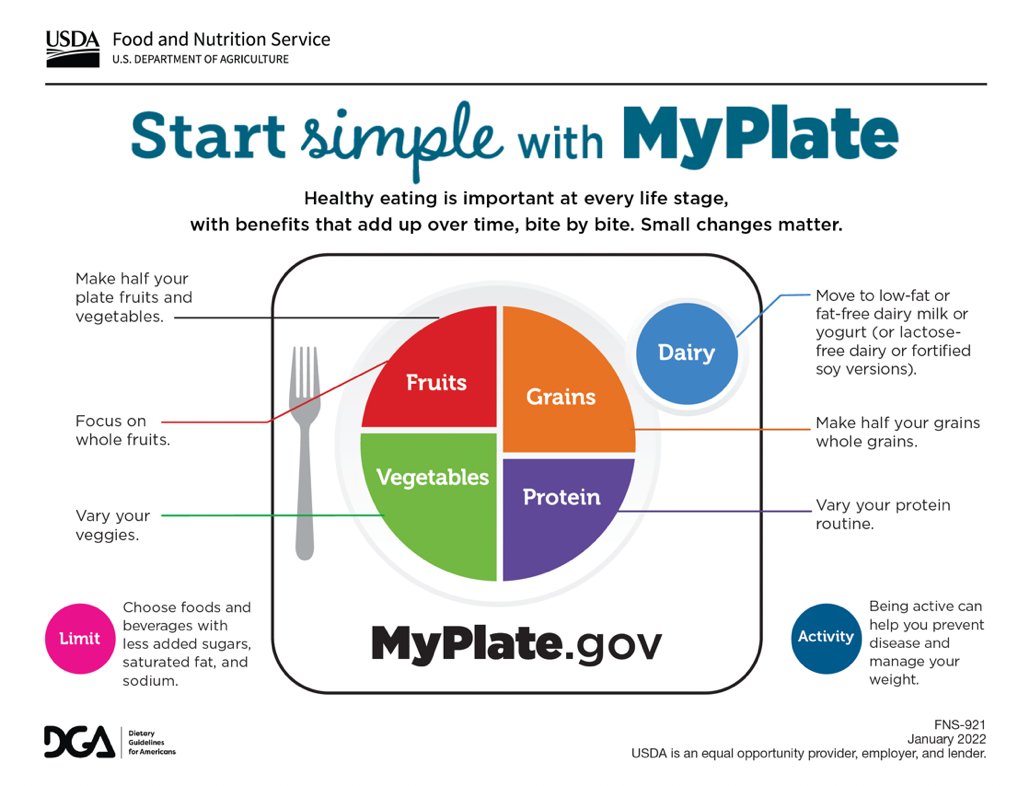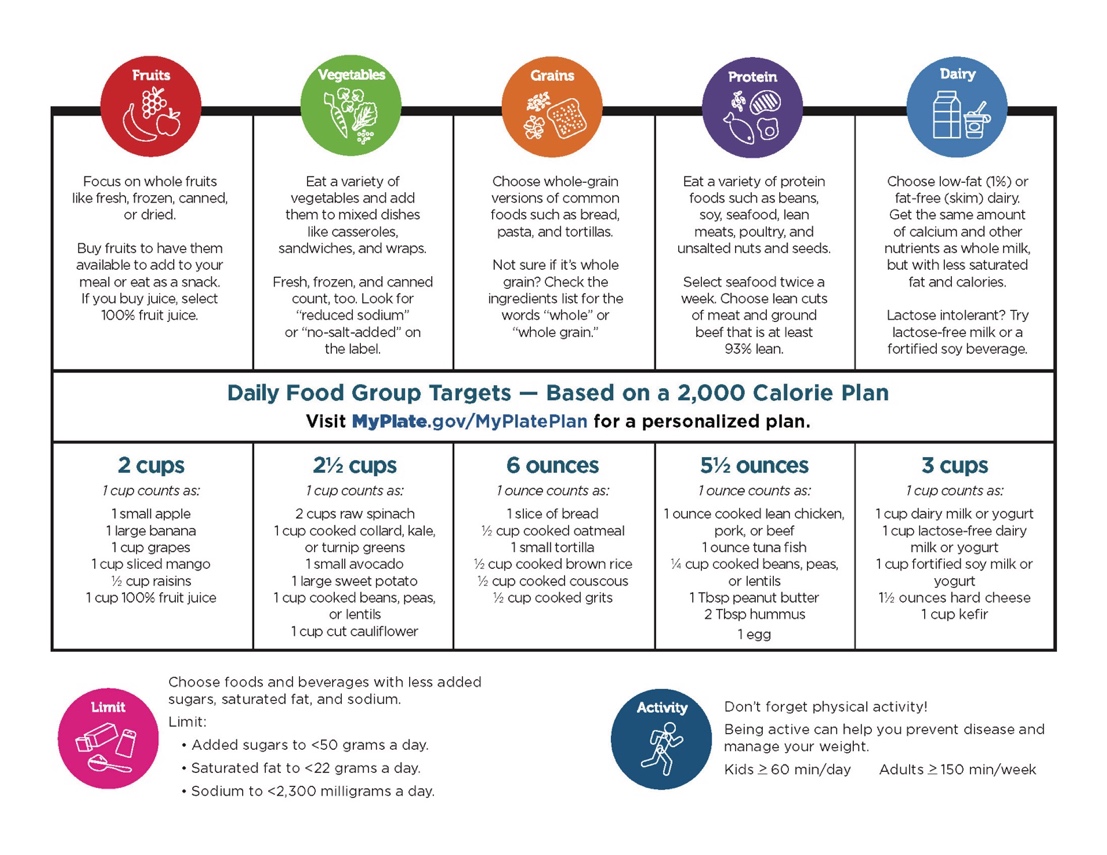Maintaining a healthy diet can be challenging in today’s fast-paced world. Diet quality can have an important impact on the ability to perform everyday activities and overall health. In an effort to help Americans improve diet quality and increase physical activity, the “Dietary Guidelines for Americans” document was created. Formally known as MyPyramid, the MyPlate nutrition guide is used by healthcare corporations, media outlets, grocery retailers, health professional associations, restaurant chains, food manufacturers, schools, and more to help integrate the content of the Dietary Guidelines into everyday habits. This publication explores the background and importance of MyPlate, how it works, and how the Expanded Food and Nutrition Education Program (EFNEP) utilizes MyPlate to help individuals, communities, and families throughout South Carolina. Nutrition and healthcare providers, educators, and those who would like to find resources to improve diet quality will benefit from the information presented in this publication.
What is MyPlate?
The U.S. Department of Agriculture (USDA) introduced the MyPlate guide to address the complex issue of healthier eating and empower individuals with the knowledge they need to make informed dietary choices.1 This intuitive visual representation offers practical guidelines for creating balanced meals that support overall well-being (figure 1).

Figure 1. The MyPlate Start simple diagram showing proportions of food groups for a healthy diet. Image courtesy of the U.S. Department of Agriculture.
Modern lifestyles, characterized by convenience-driven diets, have increased diet-related health issues such as obesity, diabetes, and cardiovascular diseases. Amidst these challenges, MyPlate is crucial, guiding individuals toward a more balanced and nutrient-rich diet. The MyPlate guide serves as a bridge between the Dietary Guidelines and practical implementation.
The Dietary Guidelines, developed by experts and health professionals, offer comprehensive recommendations based on scientific evidence to promote health and prevent chronic diseases. MyPlate, in turn, translates these guidelines into a visual and user-friendly format to teach the principles of healthier eating.1 It prioritizes the inclusion of the correct proportions of suggested choices from the five major food groups: fruits, vegetables, grains, protein, and dairy. Those who follow the MyPlate guide as their daily eating plan do not require additional vitamin or mineral supplements, as the recommended food choices contain adequate amounts.
How Does It Work?
MyPlate applies the concepts of Dietary Guidelines through practical advice, offering tangible tools that help individuals move from theory to action by learning to choose nutrient-rich foods and adopting habits that promote overall health.1 Furthermore, MyPlate encourages moderation, portion control, and mindful eating.1 One of the reasons why MyPlate is an impactful resource is because it resonates with people’s innate understanding of portioning through visual cues. Education on the components of a healthy diet fosters a more intuitive relationship with food and helps shift from rigid dieting towards sustainable dietary patterns.1
MyPlate has five major food groups that are strategically proportioned and color-coded. The color-coded sections—red for fruits, green for vegetables, orange for grains, purple for protein, and blue for dairy—show how much of each food group people should consume and how important it is to have a variety of colors throughout meals (figure 2).
MyPlate teaches the importance of specific recommendations2:
- Choosing a variety of food
- Balancing the food items from different food groups
- Eating a variety of foods that are different colors
- Making half of your plate contain fruits and vegetables
- Focusing on eating whole fruits (instead of juice)
- Ensuring at least half of the grains you consume are whole grains
- Choosing fat-free or low-fat (1%) milk and yogurt (or lactose-free dairy or fortified soy versions)
- Drinking water instead of sugary drinks like sodas, sports drinks, etc.
- Avoiding large portions1
Understanding that every meal or snack you eat will not contain every food group is essential. MyPlate encourages people to include three or more of the five food groups in each meal or snack to meet daily nutrient needs and contribute to healthier living. MyPlate guidelines provide daily food group target recommendations based on a 2,000-calorie plan.3 The MyPlate.gov/MyPlatePlan website can help individuals customize a daily plan.3

Figure 2. The MyPlate Start Simple diagram identifies daily food group targets. Image courtesy of the U.S. Department of Agriculture.
The Five Major Food Groups Breakdown
A healthy eating routine can positively affect every stage of life. Incorporating a variety of fruits, vegetables, grains, protein, and dairy or fortified plant-based alternatives is essential for establishing healthier eating habits. Each food group contributes different nutrients and health benefits our bodies need to function properly. Regularly skipping specific food groups can cause deficiencies of particular vitamins, minerals, and nutrients, which could lead to various illnesses and diseases.2
Focus on Whole Fruits!
Fruits contain vitamins, minerals, and fiber. The fruits section in the MyPlate guide is slightly smaller than the vegetable section, but the two groups should make up ½ of your plate.1,2 Choose whole fruits like fresh, frozen, canned, or dried when available. Fruits can easily be added to your meals or snacks. Whole fruit is a more nutritious option than fruit juices because juices tend to have more sugar and calories per serving and reduced fiber.1 If you buy juice, select 100% fruit juice. Don’t forget to vary the type and color of fruits you eat to receive various vitamins and minerals that will contribute multiple benefits. MyPlate recommends eating at least 2 cups of fruit each day.1
Vary Your Vegetables!
The vegetable section of the MyPlate guide is the most extensive section.1,2 Vegetables provide many of the vitamins and minerals our bodies need to help keep us feeling full longer and our digestive systems working properly.2 As with fruits, it is essential to consume a variety of vegetables. Dark green vegetables, red/orange vegetables, and beans/peas are important because they vary in nutrients. Adding a variety of vegetables to mixed dishes like casseroles, rice, sandwiches, and wraps is a convenient way to add more vegetables to your diet. Vegetables can be fresh, frozen, or canned.1 When purchasing canned vegetables, look for “reduced sodium” or “no-salt-added” on the labels for healthier options. MyPlate recommends eating at least 2½ cups of vegetables daily.1
Make Half Your Grains Whole!
The grains section is about ¼ of the MyPlate graphic.1,2 When consuming grains throughout the day, choose whole-grain versions of common foods such as bread, pasta, and tortillas. Whole grains (like whole-wheat flour) are more nutritious and have a lot of dietary fiber which helps keep us feeling full longer.2 Refined grains (e.g., white flour) are processed (partial) grains. Processed grains have had vitamins, minerals, and fiber removed. To ensure you receive your vitamins, minerals, and fiber, at least half of your grains should be whole grain (e.g., whole-wheat bread, brown rice, quinoa, or oatmeal).1,2
If you are unsure how to determine if food is whole grain, check the ingredient list for the words “whole” or “whole grain”.2 You can also check the amount of dietary fiber per serving; the higher the number, the better. MyPlate recommends eating at least 6 ounces of grains each day.1
Vary Your Source of Protein Foods!
The proteins section is about ¼ of the MyPlate graphic. High-protein foods such as beans and peas, soy, seafood, lean meats, poultry, eggs, nuts, and seeds help the body build and maintain muscles, skin, blood, and other tissues.1,2 They also contribute essential vitamins and minerals like iron.2 When choosing high-protein foods like meat and ground beef, it is important to choose lean cuts of meat and at least 93% lean ground beef for healthier options.3 MyPlate recommends eating at least 5½ ounces of protein on a daily basis.1 For reference, the palm of your hand or a deck of cards is about the same size and thickness as a 3-ounce serving of meat, fish, or chicken.4,5
Low-Fat, Fat-Free, and Plant-Based Dairy!
Dairy products are rich in calcium, which helps to build and maintain strong bones and teeth. Foods from the dairy group also have protein and vitamin D. In the MyPlate graphic, dairy is depicted as a “side” to your meal, like a glass of milk.3 However, dairy can be a part of your meal, like cheese on a sandwich or burger, or served as a snack or dessert, like yogurt parfaits with fresh fruit and granola or a fruit smoothie made with low-fat milk and yogurt. Dairy products include milk, yogurt, and cheese. Calcium-fortified soy milk and yogurt are recognized within the dairy group.3 Plant-based options are suitable for those embracing a plant-based lifestyle and provide essential nutrients. When choosing plant-based alternatives, focus on low-fat or fat-free options to mirror the nutritional benefits of traditional dairy with reduced saturated fat and calorie content. For lactose intolerance, try lactose-free milk or a fortified soy beverage.3
It is best to choose low-fat (1%) or fat-free (skim) dairy products. These dairy products have the same amount of calcium and other nutrients as whole milk but with less saturated fat and calories. MyPlate recommends consuming at least 3 cups of dairy each day.3
How MyPlate Helps EFNEP Participants
EFNEP is a nutrition education program funded through the USDA for low-income populations. EFNEP curricula are based on the latest nutrition research reflected in the current Dietary Guidelines and are tailored to the needs of its audience.6 Through EFNEP programming, participants utilize MyPlate to cultivate healthier eating habits that help reduce future healthcare costs and improve quality of life.6 To learn more about the offerings available from the Clemson Cooperative Extension EFNEP Program or find contact information for EFNEP Nutrition Educators in your area, visit the website, clemson.edu/extension/efnep.
Summary
In conclusion, the MyPlate guide represents a pivotal advancement in the journey towards healthier eating. It bridges the gap between scientific recommendations and practical implementation, offering a visual representation that empowers individuals to make better dietary choices by reinforcing the core principles of balanced nutrition. Research supports the efficacy of the MyPlate approach in promoting healthier eating habits. Studies show participants who followed MyPlate’s recommendations demonstrated improved nutrient intake and a greater likelihood of meeting dietary guidelines.1 Following the MyPlate recommendations of including three or more of the five food groups in each meal or snack will help individuals meet daily nutrient needs and contribute to healthier lives.
References Cited
- Jackson EG. Eat smart! MyPlate and 2010 dietary guidelines. Journal of Nutrition Education and Behavior. 2013 Jul;45(4):383-e7. https://doi.org/10.1016/j.jneb.2013.01.010.
- Nemours TeensHealth. MyPlate Food Guide. Jacksonville (FL): Nemours Children’s Health; 2022 Apr. https://kidshealth.org/en/teens/myplate.html.
- USDA. What is My Plate? Learn How to Eat Healthy with MyPlate. Washington (DC): My Plate, U.S. Department of Agriculture. https://www.myplate.gov/eat-healthy/what-is-myplate.
- Baker SS, McDonnell B. Eating smart • being active. New rev. ed. Fort Collins (CO): Colorado State University; 2023. https://eatingsmartbeingactive.colostate.edu/.
- Virginia Tech, Department of Nutrition, Foods, and Exercise; Virginia Cooperative Extension, 4-H Youth Development Program. Teen cuisine leaders guide: a cooking and nutrition education curriculum for teens grade 6 to 12. Blacksburg (VA): Virginia Cooperative Extension; 2018 July. https://ext.vt.edu/content/dam/ext_vt_edu/topics/food-health/family-nutrition-program/VCE-Teen-Cuisine.pdf.
- Auld Baker S, Conway L, Dollahite J, Lambea MC, McGirr K. Outcome effectiveness of the widely adopted EFNEP curriculum eating smart being active. Journal of Nutrition Education and Behavior. 2015;47(1):19–27. https://doi.org/10.1016/j.jneb2014.07.001.
Additional Resources
McCarter AS, Hwang E. 4-H healthy movers curriculum. Clemson (SC): Clemson Cooperative Extension, Land-Grant Press by Clemson Extension; 2022 Feb. LGP SC4H. https://lgpress.clemson.edu/publication/4-h-healthy-movers-curriculum/.

